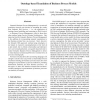3597 search results - page 118 / 720 » Model-theoretic semantics for the web |
104
click to vote
STAIRS
2008
14 years 11 months ago
2008
The success of the Semantic Web depends both on the definition of ontologies used to represent the knowledge as on the annotations performed of the web contents. As manual approach...
KBS
2008
14 years 10 months ago
2008
As the number of available Web services increases there is a growing demand to realise complex business processes by combining and reusing available Web services. In this context,...
CN
1999
14 years 9 months ago
1999
Traditional techniques for a distributed web server design rely on manipulation of central resources, such as routers or DNS services, to distribute requests designated for a sing...
102
click to vote
ICIW
2009
IEEE
15 years 4 months ago
2009
IEEE
Semantic Business Process Management is a recent and promising research area devoted to extending the results from Semantic Web Services — i.e., the application of ontology-base...
EDBT
2008
ACM
14 years 11 months ago
2008
ACM
The goal of the Semantic Web is to support semantic interoperability between applications exchanging data on the web. The idea heavily relies on data being made available in machi...




